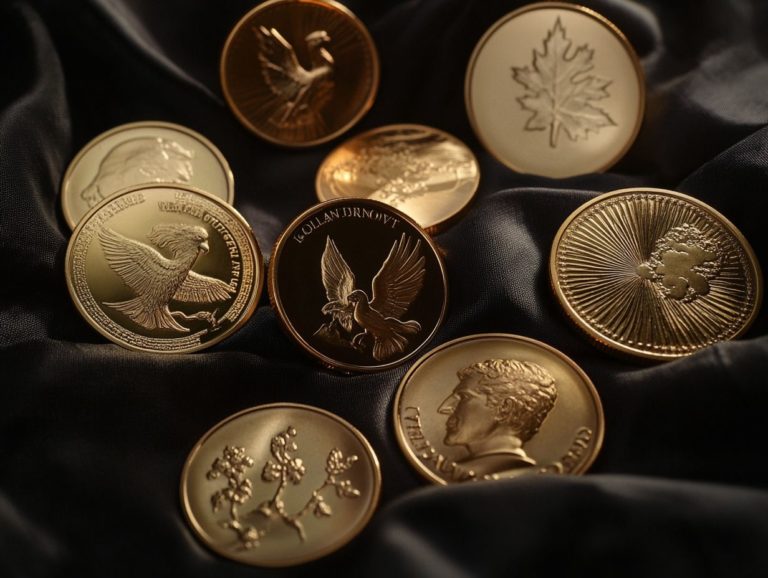What Drives Gold Prices?
Gold has long been your go-to safe haven as an investor. But do you ever wonder what really drives its price fluctuations?
This article delves into the fundamental concepts behind gold prices, illuminating the market dynamics and trends that shape its value. You ll discover how economic and political influences, along with the intricate interplay of supply and demand, play crucial roles in this arena.
You will also explore historical trends, gain insights from expert predictions, and uncover strategies for making sound investments. Whether you re a seasoned investor or just embarking on your journey, this guide will arm you with the knowledge needed to navigate the gold market with confidence.
Contents
Key Takeaways:
- Gold prices are influenced by a variety of economic and political factors, as well as supply and demand.
- Historical trends and key events have a significant impact on gold prices.
- Expert opinions and forecasting methods can help predict future gold prices, but investing in gold also involves considering risks and developing effective strategies.
The Basics of Gold Prices
Gold prices act as a vital barometer of economic stability and investment potential within financial markets. Grasping the fundamentals of these prices is essential, whether you’re a seasoned investor or a newcomer eager to diversify your portfolio.
Various factors, such as inflation rates, interest rates, and geopolitical conditions including central bank purchases and the strength of the U.S. dollar, play a significant role in determining the value of gold. Additionally, palladium: a rising star in precious metals is also becoming increasingly relevant in this context.
This precious metal is more than just a commodity; it serves as a safe-haven asset during economic downturns. A safe-haven asset is an investment that is expected to retain or increase its value during times of market turbulence, making it a critical element of any robust investment strategy centered around gold.
Understanding the Market and Trends
Understanding the market and trends surrounding gold entails a thorough examination of gold demand, production rates, and the pivotal role central banks play in pricing.
These elements intricately interconnect, creating a complex dynamic that can significantly influence the market. For instance, during times of economic uncertainty, you may notice a surge in gold demand as investors flock to safe-haven assets. Central banks are key players in this narrative; their adjustments to gold reserves can either uplift or suppress market prices based on whether they are buying or selling.
Furthermore, fluctuations in gold production rates, shaped by mining efficiency and geopolitical stability in gold-rich regions, introduce additional layers of complexity. It becomes essential for you to remain attuned to these shifting factors, as they can profoundly impact your understanding of the gold market.
What Influences Gold Prices?
Numerous factors influence gold prices, so it s crucial for you to stay well-informed about the intricate interplay of economic and political conditions that impact the market.
Understanding these dynamics empowers you as an investor to navigate the complexities of this precious commodity effectively.
Economic Factors
Economic factors like inflation rates, interest rates, and the overall economic climate are crucial in shaping the value of gold.
As you keep a close eye on these variables, you’ll recognize that fluctuations in inflation can diminish purchasing power, often prompting a shift toward gold as a reliable hedge. On the flip side, when interest rates rise, they typically bolster the U.S. dollar, which inversely impacts gold pricing. A stronger dollar makes gold more expensive for foreign currency holders. Additionally, it’s important to consider the relationship between palladium and electric vehicles, as market trends in these areas can also influence precious metal dynamics.
Additionally, geopolitical uncertainties and shifts in monetary policy can stir volatility, swaying investor sentiment and demand for gold. Monetary policy refers to the actions taken by central banks to control the money supply, which can affect interest rates and, in turn, gold prices. Thus, grasping these interconnected factors, along with insights from Palladium vs Platinum: Market Analysis, is essential for anyone keen on tracking the movements in the gold market.
Political Factors
Political factors, including geopolitical tensions and central bank policies, have a profound influence on gold prices, often prompting you to consider this precious metal as a secure investment.
When conflicts arise, such as the ongoing crisis between Russia and Ukraine, uncertainties in the global market can lead to a surge in demand for gold. During times of turmoil, many investors turn to gold as a safe haven, which inevitably drives its price higher.
Additionally, actions taken by European central banks like adjustments in interest rates or quantitative easing can significantly alter market dynamics. Quantitative easing is a strategy where central banks inject money into the economy to stimulate growth.
For instance, when interest rates drop, the opportunity cost of holding gold decreases, making it a more appealing investment. Therefore, grasping these political influences is essential for anyone looking to navigate the complex environment of gold investment.
Supply and Demand
Supply and demand dynamics are essential in shaping gold prices. Rising demand often triggers price surges, while production levels play a key role in mitigating these fluctuations.
As you navigate this landscape, understanding how these forces interact is vital for crafting effective investment strategies. When demand for gold increases whether due to geopolitical tensions, economic uncertainty, or shifts in consumer behavior it often signals a potential rise in prices.
This positions gold as a reliable safe haven for wealth preservation. On the other hand, a significant increase in production levels, perhaps driven by technological advancements in mining or new discoveries, could stabilize or even lower prices, influencing investor sentiment.
Thus, if you’re considering investing in gold, it’s crucial to keep a close eye on market conditions and adjust your strategies accordingly to make the most of these trends.
Historical Trends in Gold Prices
Historical trends in gold prices offer you an intriguing insight into how this precious metal has reacted to different economic downturns and significant events over the decades. By examining these patterns, you can glean valuable insights that will inform your future investment decisions.
Key Events and Their Impact
Key events such as financial crises, geopolitical conflicts, and central bank policies have historically greatly affected gold prices, making it essential for you to grasp these dynamics as an investor.
Take the 2008 financial crisis as an example. It triggered a massive flight to safety, propelling gold prices to unprecedented heights. Investors sought refuge from the turbulence of volatile stock markets and a weakening dollar.
Ongoing tensions in areas like the Middle East can create a climate of uncertainty, often resulting in spikes in demand for gold as a safe-haven asset. Additionally, understanding the palladium supply chain: trends and risks is crucial, as changes in monetary policy from the Federal Reserve can also impact gold’s appeal, stirring financial markets and affecting economic stability across the globe.
Predicting Future Gold Prices
Predicting future gold prices demands a sophisticated blend of expert insights and forecasting techniques. You’ll need a keen understanding of market dynamics and economic indicators to navigate this complex landscape effectively.
Expert Opinions and Forecasting Methods
Expert insights from renowned analysts, including perspectives from J.P. Morgan and Steve Azoury, offer invaluable forecasting methods to navigate the complexities of future gold prices amid shifting economic landscapes.
These authorities stress the necessity of monitoring pivotal indicators like inflation rates, interest rates, and geopolitical stability to fully understand potential fluctuations in gold prices.
By blending technical analysis (analyzing past market data for trends) with fundamental forecasting, they advocate for a diversified strategy that considers market sentiments and historical trends, ultimately leading to more precise predictions.
Moreover, the influence of central bank policies on currency values significantly affects the demand for gold as a safe-haven asset. Investors should stay alert to global economic changes and their consequences for precious metals, including factors affecting palladium prices.
Investing in Gold
Investing in gold presents you with a wealth of options, from gold ETFs to coins and bars, enabling you to diversify your investment portfolio. This strategy not only enhances your asset mix but also helps mitigate the risks tied to economic uncertainty.
Now is the time to explore diverse gold options to safeguard your assets!
Strategies for Maximizing Profits
Developing effective strategies for maximizing profits in gold investment requires you to be acutely aware of market conditions and to have a deep understanding of gold value fluctuations.
You need to consider various factors that can influence gold prices, such as global economic trends, geopolitical events, and currency strength. A well-informed investor like you will explore options such as physical gold, exchange-traded funds (ETFs), and mining stocks, each offering its own unique advantages. Additionally, understanding the growing influence of palladium in global markets can also provide valuable insights into precious metals investments.
By keeping an eye on interest rates and inflation, you can better position your investments to respond to market shifts. Understanding these dynamics is crucial for making timely investment decisions that can significantly boost your profits, ensuring you remain competitive in this ever-evolving landscape.
Risks and Considerations
Investing in gold comes with its own set of exciting challenges that you must thoughtfully assess in relation to the ever-evolving economic and market landscape.
For instance, changes in currency values can profoundly affect gold’s purchasing power, making it vital for you to keep an eye on global economic indicators. Geopolitical tensions and market volatility can trigger abrupt shifts in demand, directly influencing gold prices.
Factors like inflation rates and interest rate fluctuations are also significant; typically, higher interest rates diminish gold’s allure compared to investments that provide regular income. Recognizing these variables is essential for anyone aiming to navigate the intricate world of gold investment with confidence and finesse.
Frequently Asked Questions
-
What drives the price of gold?
-
How does global demand affect gold prices?
-
Do economic conditions play a role in gold prices?
-
What role does central bank policy play in gold prices?
-
How do political events affect gold prices?
-
What impact do interest rates have on gold prices?
The price of gold is influenced by a variety of factors, including supply and demand, economic conditions, and investor sentiment. These factors can cause fluctuations in the price of gold on a daily basis.
Gold is a globally traded commodity, so changes in demand from major markets such as India and China can have a significant impact on its price. If demand increases in these markets, the price of gold is likely to rise.
Yes, economic conditions such as inflation, interest rates, and the strength of the US dollar can all impact the price of gold. In times of economic instability, investors often turn to gold as a safe-haven asset, which can cause the price to rise.
Central banks hold a significant amount of gold as part of their currency reserves. Changes in their policies, such as buying or selling gold, can have a major impact on the market and drive gold prices up or down.
Political events, such as elections, geopolitical tensions, and trade disputes, can cause uncertainty and volatility in the markets. This uncertainty often leads investors to seek out the stability of gold, driving up its price.
Interest rates and gold prices have an inverse relationship. When interest rates are low, the opportunity cost of holding gold decreases, making it a more attractive investment. As interest rates rise, the demand for gold may decrease, causing its price to fall.
Stay informed and take action to secure your investments today!













